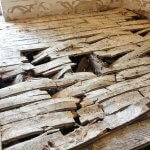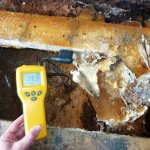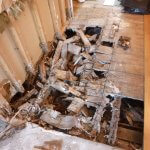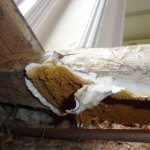Timber Preservation Specialists
The vast majority of structures throughout the UK have large sections of the building formed from timber elements. Be it the suspended floor structures of the property, supporting beams and posts, internal stud-work or simply the roof, timber has been used for thousands of years and is still one of the most commonly used building materials today.
It is therefore no surprise that decay by fungal growth and infestation by wood boring insects is incredibly common.
Wet and Dry Wood Rot
The terms ‘wet’ or ‘dry’ rot can often be misleading. Although both differing types of fungal growth, all timber decay requires some form of moisture to allow a fungal outbreak to flourish.
All forms of wood rotting fungi break down wood cells as a source of food causing loss of section and structural strength in the timber. For this to occur the timber must be damp. Moisture content is critical in the germination and development of the fungi. In a well maintained property the risk of fungal attacks is minimized.
When timbers become damp due to external defects, poor structural detailing or in some cases excessive condensation, the timbers become damp and fungal decay can germinate.
Dry Rot
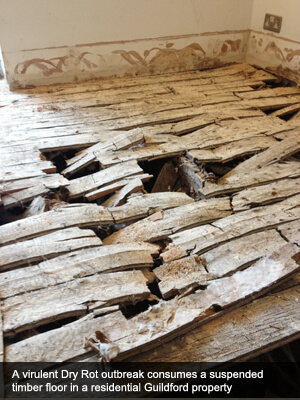
The most destructive of the fungal decay affecting timbers in UK homes is True Dry Rot [Serpula Lacrymans]. This fungus is often described as the cancer of buildings, which will rapidly destroy all timbers in its path. While this may well be a slight exaggeration fuelled by myth and extreme cases, Dry rot is probably the most destructive and costly of all the wood destroying fungi affecting buildings due to it being a secretive fungus and having the ability to grow searching mycelium akin to a plant root system.
Wet Rot
Wet rot is the common name given to all wood rotting fungi other than the True Dry rot fungus. As with dry rot, wet rot is simply natural decay within timber that becomes damp in the presence of high moisture exposure. Generally there is a structural or design fault causing the timbers to become damp and the decay is often more localised and obvious.
Our Answer
Whether wet, dry, active or historic, we will start off by identifying the likely source of water which is causing the rot and how far the decay has spread- after all, dry wood will not rot!
Our PCA qualified surveyors are trained to diagnose the type and characteristics of all common rots prior to choosing a remedial strategy. Care and attention is paid to the rectification of any defects causing the wetting, prior to the specification of only required treatments to remove the decay and improve conditions to reduce the risk of the rot coming back.
Where possible we maintain as much of the original structure and materials as we can, and only specify chemical or preservation treatments where required – especially important when the work is being carried out on listed and/or historic buildings.
‘Woodworm’
Wood-Boring Insects
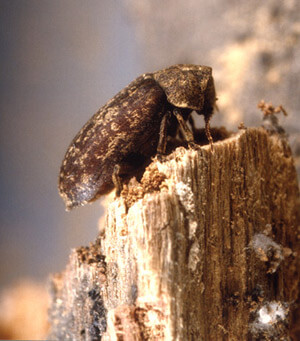 ‘Woodworm‘ is the common used term when discussing wood boring insect damage. It gets its name as the damaging tunneling is carried out by the Larvae of the relevant beetle species.
‘Woodworm‘ is the common used term when discussing wood boring insect damage. It gets its name as the damaging tunneling is carried out by the Larvae of the relevant beetle species.
The wood boring beetle most commonly found in properties is the Common furniture beetle [Anobium Punctatum].
In some cases however, more rare types of insect infestation are found largely dependent on the species of timber and how damp the wood has become.
Deathwatch beetle [Xestobium rufovillosum] for example is a larger beetle more often encountered in older buildings where it is mostly found attacking oak.
There are many forms of woodworm but not all need treatment, most can be found and identified by carefully studying the holes created by beetles when emerging from the wood.
Our Answer
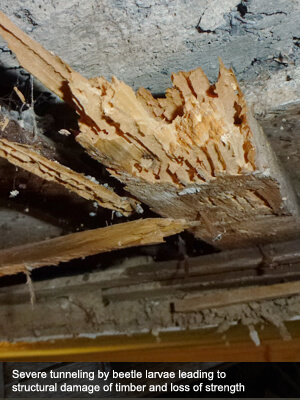 As there are many types of beetle all with their own characteristics, our surveyors are trained to diagnose the likely species of beetle and if an attack is active, dead or simply the result of an innocuous wood boring insects that will not require any treatment.
As there are many types of beetle all with their own characteristics, our surveyors are trained to diagnose the likely species of beetle and if an attack is active, dead or simply the result of an innocuous wood boring insects that will not require any treatment.
Should an attack be active, we will then carry out the most appropriate and low risk preservative applications to eradicate any infestation. All of which is done whilst trying to retain as much of the original timber as we can.
Our professional approach attempts to ensure minimal disruption to occupants, whilst achieving a quick re-occupancy time into a safe and protected environment.
As each case is different and all structures can vary significantly, the best way of determining if you have any active fungal decay or a beetle infestation is to arrange a survey of the areas of concern.
Should you wish to speak to a member of our expert team, you can find details on how to get in touch on our contact page.
Alternatively, CLICK HERE to start your enquiry and book a survey today.
